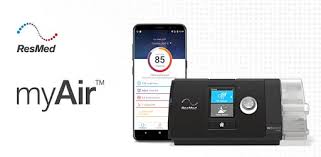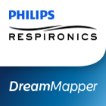CPAP/BIPAP User Guide
Sleep apnea is a disorder that causes people to frequently stop breathing for short periods while sleeping. As a result, they fail to get: A restful night's sleep. The oxygen their body needs If left untreated, sleep apnea increases the risk of high blood pressure, heart problems and stroke.
CPAP (Continuous Positive Airway Pressure) is utilized for the treatment of obstructive sleep apnea. Your doctor has prescribed a CPAP System for your use at home for the treatment of obstructive sleep apnea. The equipment delivers a flow of air at a prescribed amount of pressure, applied through a mask over the nose. This pressure prevents the structures in your throat from blocking air movement in and out of your lungs while you sleep. You will experience almost immediate relief from your symptoms by using CPAP Therapy. If your doctor has prescribed oxygen and/or a humidifier along with the CPAP system, this will be explained to you during your training.
GENERAL INSTRUCTIONS
This system has been prescribed by your doctor. It is important that you use the system EXACTLY as your doctor prescribed. The pressure (and other settings if applicable) has been prescribed specifically to treat your disorder. These settings have been made to your CPAP devise according to what your doctor prescribed, and can not be changed without consulting your doctor. Read the Operating Instructions that have been provided by our representative. These instructions are written specifically for the system you have been provided. These instructions serve as a reference. They should be used in conjunction with the instructions and protocol set by the doctor ordering the system and the training provided by our representative. We provide 24-hour service to assist you with any problems you may encounter. However, CPAP therapy is not a life sustaining form of treatment and most services will be provided during normal business hours.
RECOMMENDED CLEANING PROCEDURE
For Expiration valve (when applicable), nasal mask/pillows
Each morning
Disassemble and wash with liquid dish washing detergent and warm tap water in clean basin or container.
Rinse well with clear warm running tap water. Proper rinsing reduces the potential for skin irritation resulting from soap residue.
Air dry. Reassemble when dry.
If still damp when ready to use, assemble the nasal mask/pillows to the swivel and then to the hose. Attach the other end of the hose to the flow generator. Turn the generator on and allow these items to blow dry for 10 to 20 minutes.
Once a month or as needed
Hand wash headgear with laundry detergent, rinse well; line dry. DO NOT put into washing machine.
Every Week
Clean tubing in liquid dish soap and water solution, rinse thoroughly ; air dry.
Humidifier Your physician may have prescribed a humidifier to be used in conjunction with your CPAP unit. Wash humidifier with mild dish detergent and water DAILY. Use only DISTILLED water in humidifier (Tap Water may damage the unit.)
Flow Generator Cabinet Once a week, unplug the unit and wipe the outside of the cabinet with a cloth slightly dampened with warm water. NEVER immerse the unit in water or allow water to enter any vents or ports. Make sure the unit is completely dry before plugging in.
Filters Clean and/or replace filters as instructed by our representative. (Refer to Operating Instructions.) Disposable filters are normally replaced every 4-6 weeks, and the non-disposable cleaned once per week.
Headgear / Softcap and Straps These items should be washed once a week using mild detergent and warm water either by hand or in the washing machine. NEVER place in a dryer. Always hang to dry
HELPFUL HINTS
Washing your face with soap and water to remove excess facial oils before putting on the nasal mask helps prolong the life of the mask and headgear / softcap and straps. Once the straps are properly adjusted, the mask and headgear / softcap can be removed and reapplied by unfastening or loosening one strap only. You can mark the positions where the end of each strap is fastened to the velcro with a permanent marker for easy adjustment after washing. A tighter fit is NOT necessarily better. It can be as loose as desired as long as you are able to maintain a seal. If you are using a room humidifier, please be sure that it is placed at least six feet from your CPAP system.
SAFETY PRECAUTIONS
If supplemental oxygen is being used in conjunction with your system, this equipment must be kept away from heat or open flame. Smoking in the area of this device is absolutely prohibited.
When using supplemental oxygen, make sure that the CPAP System is running before the oxygen source is turned ON. Turn the oxygen flow OFF first before turning the System OFF.
To avoid electrical shock unplug the unit before cleaning or changing the fuses. The System must be positioned on its base on a level, secure surface for proper operation.
DO NOT block the vents and filter openings of your unit. Air must flow freely around the unit for the system to work properly. Make sure that bedding, draperies, curtains, etc. do not restrict airflow.
Tobacco smoke will cause tar build-up that may result in the units malfunctioning. Do not permit smoking in the room with the unit.
Do not use the system around water, other than that contained in the humidifier. Electrical shock may occur.
All settings must be determined by your doctor through appropriate diagnostic studies and monitoring. These settings are to be adjusted only by authorized personnel in compliance with your doctor's prescription.
This system must never be turned on and left unattended. If your system is dropped or otherwise damaged, or if any liquid is spilled into the system, do not use. Contact our office immediately. Never try to repair your unit yourself. If needs to be repaired by qualified medical repair professionals. If you are renting this equipment please contact us and your unit will be replaced immediately.
Make sure that all fittings and connections have been properly secured prior to use. The exhalation port/valve on your mask system is designed to exhaust CO2 (carbon dioxide) from the patient circuit. Continuous flow is required for safe operation. Do not block or try to seal the exhalation opening.
If using a mask that covers your mouth and nose, do not eat or drink for two to three hours prior to bedtime.
Read and understand your Operating Instructions prior to using your system. If you have questions contact our office.
It is recommended that you not plug your system into an outlet that is controlled by a wall switch.
Your system is not intended for life support.
ROUTINE MAINTENANCE
There are no user-serviceable components in your system. DO NOT attempt to open the enclosure or service this device. Supplies such as masks and tubing should be replaced approximately once a year for hygienic purposes.
We have found that most masks start to lose their shape and tend not to hold their seal in the 3-6 month range of use. Most headgear will last about 12-18 months if taken care of well. Tubing will generally last 12-18 months, although we recommend replacing it once a year. It may seem that it will last longer but usually it starts to break down and fray around the 18-month mark. Most insurance carriers will cover replacement accessories annually. Improper care of your accessories such as washing in the washing machine and/or dishwasher or boiling will result in poor results from your accessories and you will have to replace them more often, which may cause a problem with insurance coverage.
ROUTINE EQUIPMENT FILTER CARE
Routine filter care is an important aspect of your CPAP/BiLevel therapy success. Proper filter care ensures that you are breathing air without dust, dirt, or pollens. Poor or non-existent filter care can result in your equipment overheating and burning out the motor. Dirty filters also mean that you are breathing unsanitary air, which can lead to sinus problems, allergies, and possibly other more serious respiratory problems. Proper Filter care will ensure the coverage of your warranty. If you are a new CPAP / BiLevel patient, you should call (your company name) within 3-4 weeks of receiving your CPAP to order disposable filters (if applicable). Filters and supplies are not automatically sent to you.
HELPFUL HINTS TO SUCCESSFUL CPAP / BiLEVEL THERAPY
Use your equipment whenever (bedtime & during naps) and wherever you sleep (vacations & camping trips). Keep a glass of water with a straw at your bedside. Dry mouth is an annoying and common side effect. Severe dryness may be alleviated with the use of a saline-based nasal spray and/or humidification. Contact (your company name) if symptoms persist following the use of a saline-based nasal spray.
DON’T GIVE UP!! BE PATIENT!! SOME PATIENTS NOTICE A DRAMATIC DIFFERENCE IMMEDIATELY AND FOR SOME IT CAN TAKE UP TO ONE MONTH TO BECOME COMFORTABLE AND FEEL THE BENEFITS OF THE THERAPY.
GET YOUR SPOUSE INVOLVED, HAVE HIM OR HER BE YOUR CHEERLEADER! THEY SHOULD BE SUPPORTIVE, AS THEY WILL SLEEP BETTER SINCE YOUR SNORING WILL STOP. PLEASE CONTACT HOME CARE SPECIALISTS WITH ANY QUESTIONS AND/OR PROBLEMS REGARDING YOUR THERAPY, USE OF EQUIPMENT, AND TO ORDER SUPPLIES. ALL ONGOING PATIENT CARE CLINICAL VISITS ARE SCHEDULED IN A FLEXIBLE TIMELY MANNER. WE ARE HERE TO HELP AND SUPPORT YOU.
TROUBLESHOOTING GUIDE
Refer to your Operating Instructions for such common problems as air leaks around the mask; sore or dry eyes; skin irritation; dryness or burning sensation in the throat, nose, or nasal sinuses, or ear pain; feeling that the pressure is too high or too low; air from the device seems warm; etc. The operating Instructions will give possible causes and instructions to solve the problem. Contact our office if you are unable to correct the problem.
TRAVEL TIPS
When transporting your system, precautions should be used to avoid exposure to extreme temperatures. If exposure to such temperatures does occur, the unit should be allowed to return to room temperature before being turned ON. The voltage selector switch, if applicable, must be set for the proper line voltage. Refer to the operating Instructions for a guide to line voltages/fuse size required to operate your unit when traveling outside the United States. You can also call our office for assistance prior to your travel. The carrying case, if provided, is designed to be used as an airline carry-on bag. When traveling, do not check your unit as baggage. Always use the carrying case for the unit's protection. The accessories (including the humidifier) can also be placed inside the carrying case. If your CPAP system is used on a 12-volt system in a recreational vehicle or a motor home, do not attempt to use any power cord other than the DC power cord provided by our representative. Using a different power cord may result in damage to your vehicle and/or to your CPAP system.
REMEMBER
Your doctor has prescribed your course of treatment, which involves this system. You have been instructed on the use of this system. Should any problem occur, contact our office or your doctor immediately.
Warranty: Your unit has a two year warranty. Contact Home Care Specialists for any questions about warranty at 1-800-698-8113


